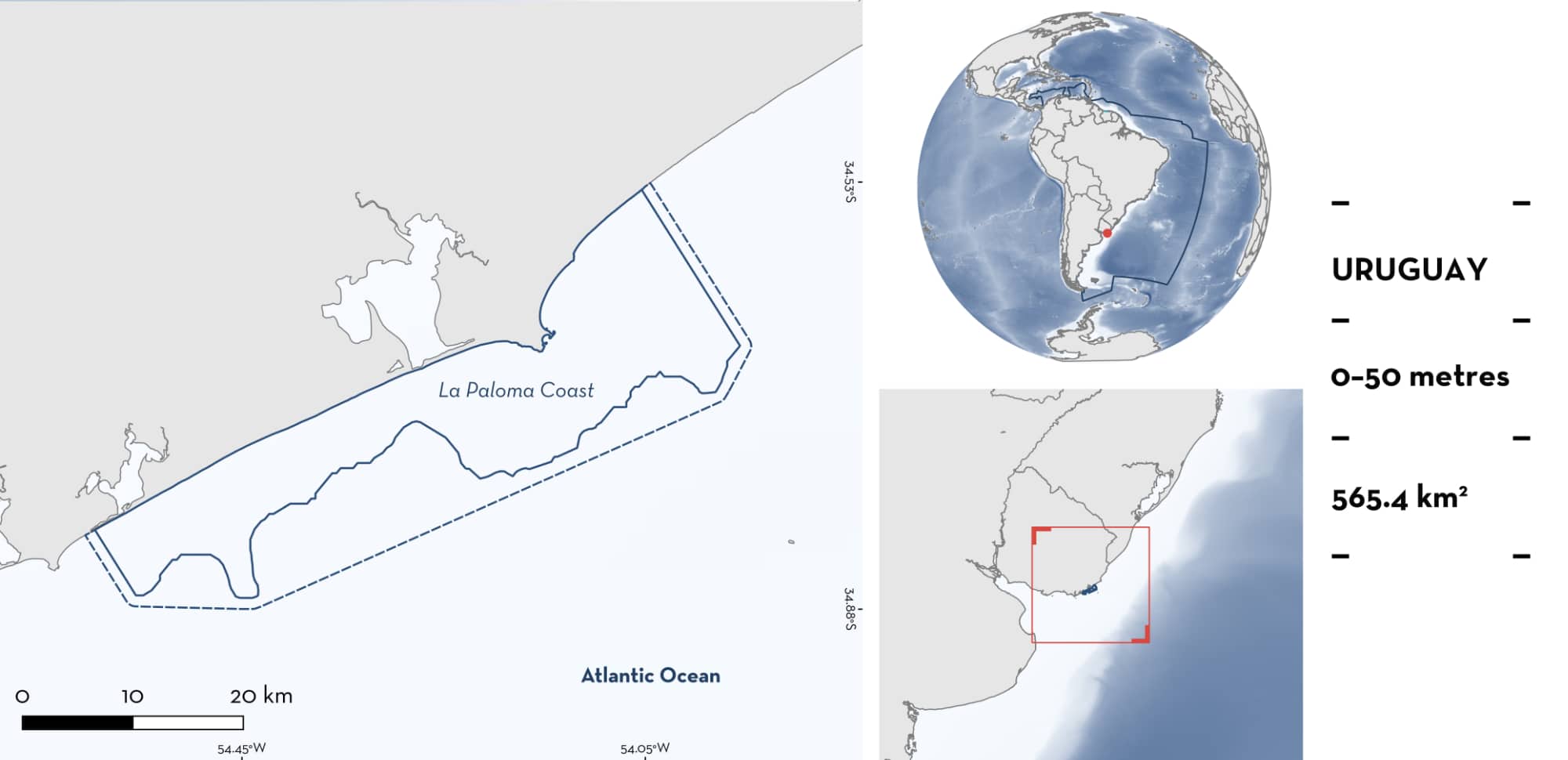ISRA FACTSHEETS
ISRA FACTSHEETS
SOUTH AMERICAN ATLANTIC REGION
La Paloma Coast
Summary
La Paloma Coast is located off the coast of Rocha department in Uruguay. The area encompasses the southern coast of Rocha and La Paloma. This coastal area lies on the continental shelf. It is characterised by sandy substrates with mud patches, rock outcrops, and rocky reefs. The area is influenced by the Malvinas-Falkland and the Brazil currents, and experiences oceanic upwelling. Within this area there are: threatened species and reproductive areas (Smooth Hammerhead Sphyrna zygaena).
Download factsheet
La Paloma Coast
DESCRIPTION OF HABITAT
La Paloma Coast is located off the coast of Rocha department in Uruguay. The area encompasses the southern coast of Rocha and La Paloma headland and lies within the continental shelf. It is characterised by sandy substrates with mud patches, rock outcrops, and rocky reefs (Pereyra et al. 2017; Finkl & Makowski 2021). The area is influenced by a seasonal regime, where the cold Malvinas-Falkland Current dominates in austral winter being displaced in summer by the Brazil Current (Trinchin et al. 2019) and by the water exchange with coastal lagoons. The area is also influenced by an oceanic upwelling zone around La Paloma associated with northeasterly winds, with the frequency of upwelling events on interannual time scales dependent on the phase of El Niño Southern Oscillation (Trinchin et al. 2019). In addition, the area is influenced by the Rio de la Plata plume (i.e., freshwater with high turbidity) with an important seasonal and inter-annual variation across the South Atlantic Coastal System (Jaureguizar et al. 2023).
This Important Shark and Ray Area is benthic and pelagic and is delineated from inshore and surface waters (0 m) to 50 m based on the bathymetry of the area.
CRITERION A
VULNERABILITY
One Qualifying Species considered threatened with extinction according to the IUCN Red List of Threatened Species regularly occur in the area. This is the Vulnerable Smooth Hammerhead (Rigby et al. 2019).
CRITERION C
SUB-CRITERION C1 – REPRODUCTIVE AREAS
La Paloma Coast is an important reproductive area for one shark species.
Between 2014–2016, the Dirección Nacional de Recursos Acuáticos (DINARA) conducted landing surveys (at La Paloma) and sampling onboard the artisanal gillnet (n = 107 trips) and longline fleets (n = 31) along the coast of Maldonado and Rocha province during the four seasons each year (Silveira et al. 2016, 2018). Information on fishing location, season, fishing gear, and biological data of the individuals (size, sex, and maturity stage) were recorded. Neonates were identified as individuals having an open or semi-healing umbilical scar or by size in comparison with the size-at-birth for the species (Silveira et al. 2016, 2018).
Between 2014–2016, 100 neonate (56% of the total capture) Smooth Hammerheads (33 individuals with open umbilical scar, and 67 by size-at-birth range), and 41 young-of-the-year (YOY) (23% of the total captured) with healed umbilical scars were captured in the area (Silveira et al. 2016, 2018). Size-at-birth for the species is 49–63 cm total length (TL; Ebert et al. 2021). Neonates and YOY ranged in size from 52–73 cm TL. The remaining 38 individuals captured were juveniles measuring <120 cm TL, which is below the maturity size (~210–265 cm TL; Ebert et al. 2021). This indicates that this area is important for the early life stages of the species. Neonates were captured during the summer months, while juveniles were captured in summer and autumn (Silveira et al. 2016). Additionally, between 2022–2024, a total of 45 formal interviews were conducted with artisanal fishers using gillnets and longlines in the area (AC Milessi unpubl. data 2025). Of these, 40 fishers reported capturing pregnant hammerheads (Sphyrna species, primarily Smooth Hammerhead) during the months of October–December each year, a pattern they have observed since the fishery began in the mid-1940s. Although pregnant females represent a relatively small portion of the catch during their presence, fishers consistently report high numbers of neonates and YOY between January and March (AC Milessi unpubl. data 2025). On average, neonates and YOY account for approximately 5% of the total annual catch of the species (AC Milessi unpubl. data 2025).
Smooth Hammerhead neonates and YOY have been reported across the Uruguayan coast around rocky areas (Doño-Melleras 2008; Silveira et al. 2016, 2018), however, La Paloma Coast has been consistently reported as an area where neonates/YOY are captured (Silveira et al. 2016, 2018).
Download factsheet
SUBMIT A REQUEST
ISRA SPATIAL LAYER REQUEST
To make a request to download the ISRA Layer in either a GIS compatible Shapefile (.shp) or Google Earth compatible Keyhole Markup Language Zipped file (.kmz) please complete the following form. We will review your request and send the download details to you. We will endeavor to send you the requested files as soon as we can. However, please note that this is not an automated process, and before requests are responded to, they undergo internal review and authorization. As such, requests normally take 5–10 working days to process.
Should you have questions about the data or process, please do not hesitate to contact us.


